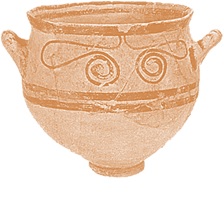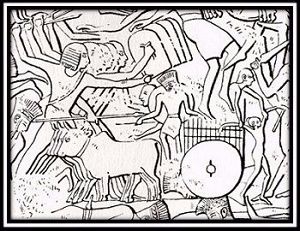 Edit article
Edit articleSeries
The Philistines: Ancient Records, Archaeological Remains, and Biblical Traditions

Emmanuel de Rougé's translation of the North wall of the mortuary temple of Ramesses III at Medinet Habu This famous scene shows what has come to be known as the Battle of the Delta.
The Origin of the Philistines According to the Bible
In rebuking the Israelites for believing themselves to be special, Amos—in the (Ashkenazi) haftara for Parashat Kedoshim—compares their history to that of the Philistines and Arameans (9:7):
הֲל֣וֹא אֶת־יִשְׂרָאֵ֗ל הֶעֱלֵ֙יתִי֙ מֵאֶ֣רֶץ מִצְרַ֔יִם וּפְלִשְׁתִּיִּ֥ים מִכַּפְתּ֖וֹר וַאֲרָ֥ם מִקִּֽיר:
True, I brought Israel up From the land of Egypt, But also the Philistines from Caphtor And the Arameans from Kir.
Jeremiah 47:4 also references Caphtor as the Philistines’ homeland, calling them “the remnant from the island of Caphtor (שְׁאֵרִ֖ית אִ֥י כַפְתּֽוֹר).” The island of Caphtor (Keftiu of the Egyptian records) is probably a reference to Crete (though some scholars argue for Cyprus). According to Gen 10:13 and I Chr 1: 11, however, the Philistines were the descendants of Egypt, while in the Abraham and Isaac narratives, the Philistines are presented as native to Canaan. What light do ancient Near Eastern records and remains shed on this issue?
Philistines in Egyptian Records
The “Peleset” are first mentioned in the records of Ramesses III from his fifth and eighth regnal years (ca. 1182-1179 BCE). They are named, together with other lesser-known peoples, among the enemies from “the islands” that have come to attack Egypt from both land and sea (KRIT V: 34-35). These nations are collectively referred to by modern scholars as the “Sea-Peoples.”Egyptologists were quick to equate the Peleset, justly, with the biblical Philistines (Hebrew: Pelishtim), while archaeologists followed suit by identifying Aegean-style (Greek-style) artifacts from sites in the southern coastal plain of Israel, as the product of this Philistine invasion. Thus, various written and material sources can be combined to answer some basic questions concerning the Philistines and their role in the history of the Ancient Near East.
Who were the Philistines?
The Egyptian records refer to the Philistines as “The foreign countries (that) made a conspiracy in their islands," (KRIT V: 34-35) thus locating their homeland in the Aegean islands (as Amos and Jeremiah both suggested). The exact location of these islands was not given in the Egyptian sources, but the same “Sea-Peoples” were alternately referred to as the “northern foreign countries.”
Etymological Analysis
A more specific place of origin was suggested according to the phonetic resemblance between the names of the “Sea-Peoples'” confederates and place names known from antiquity to the present day. Thus, the Danuna were identified with the Homeric Danaoi, the Philistines with the Palesgians, the Shekelesh with Sicily and so on. The suggested homelands of the “Sea-Peoples” therefore ranged from mainland Greece, the Aegean islands, Crete, Cyprus, west Anatolia and its offshore islands, to Syria and even Sicily and Sardinia in the western Mediterranean as well as mainland Italy. However, the exact origin of the “Sea-Peoples” cannot yet be determined based on etymological considerations.
Archaeological Analysis

Typical Philistine bell shaped bowl
Archaeological investigations into the origin of some of the “Sea-Peoples” have also been inconclusive. Philistine pottery (the Mycenaean IIIC:1b style)–the most distinct feature of the Philistine sites–has yet to be definitively identified with a specific region in the Aegean world. Instead, this style has been recognized as a typological branch of Cypriot and Cilician pottery while the decorative style, on the other hand, corresponds with motifs known from Crete, the Dodecanese and western Anatolia.
Evidence from Egyptian Art
A different approach to the question of origin was based on the Egyptian depictions of the “Sea-Peoples” in the reliefs of Ramesses III at his mortuary temple at Medinet Habu. The feathered and the horned caps of the “Sea-Peoples” were compared to Aegean headdresses and their ships to Mycenaean depictions, although the appearance of their women and children was Hittite or Asiatic by Egyptian iconic conventions. Thus, both the iconographic and the archaeological evidence cannot point to a single origin for the elusive “Sea-Peoples,” promoting the view that they were not heterogeneous but comprised of different populations amalgamated along the way.
How did the Philistines come to inhabit Philistia?
Destroyers of Civilization
The Egyptian inscriptions recount the havoc caused by the “Sea-Peoples” prior to their arrival in Egypt:
“(As for) the Foreign countries, they made a conspiracy in their isles. Removed and scattered in battle, were the lands at one time. No land could stand up against (‘before’) their arms, beginning from Hatti; - Qode, Carchemish, Arzawa and Alasia, cut off (all) at [once]. A camp [was placed] in a place within Amurru.[1] They slew its people, and its land was like that which has never come into being. They were coming, as the fire was prepared before them, towards Egypt. Their confederation was the Philistines, Sikila, Shekelesh, Danuna and Weshesh, lands united.” (KRIT V: 34-35)
The “Sea-Peoples” were, therefore, held accountable for the majority of the destructions at Levantine sites at the end of the Bronze Age. Numerous destruction layers in Syro-Canaanite towns and the northern Levant were ascribed to the “Sea-Peoples'” attacks. A growing volume of works, however, suggest other factors of social, economic and ecological nature that contributed to the end of the Bronze Age. Particular growing attention is given to the effects of a global drought on the movement of peoples at the close of the Late Bronze Age. Evidence for such a drought was recently identified in the pollen record of the eastern Mediterranean.
Mass Settlers of the Levantine Coast
Regardless of their exact role in the devastation of the Late Bronze Age empires—whether they were a primary cause of this devastation or took advantage of climactic disasters— the “Sea-Peoples” seem to have journeyed through the Levant, from north to south, in search of new settlement grounds.

This notion that the Sea Peoples migrated, looking for more land is supported by the reliefs of Ramesses III at Medinet Habu, which within the conventional battle scene of the massacred enemy, depict ox-carts, of no obvious military use, laden with women, children and non-warriors. The appearance of locally produced Aegean style pottery at various Levantine sites of the early Iron Age also support the migration hypothesis—small bands of conquering warriors do not have time or resources to produce pottery in the style of the country that they left behind.
Gradual Migration to the Levantine Coast
A wider range of interpretations for the presence of Aegean style pottery in the Levant has been put forth in recent years, rejecting the migration theory altogether or offering a more moderate and gradual process of migration. Nevertheless, there can be little doubt that new populations did inhabit the southern coastal plain of Israel in the beginning of the Iron Age.
Philistines Versus Egyptians
The dominant power on the Levantine coast before the arrival of the Philistines was the Egyptians. So how exactly did the Philistines come to inhabit Philistia and establish control there is a significant question, one that is still under debate.
Model 1 – Post Egyptian Abandonment
Early scholars accepted the Egyptian account of complete victory over the intruders and therefore uninterrupted control over the Egyptian empire in the Levant until the reign of Ramesses VI. The Philistine settlement was therefore envisioned as a process that began only after the Egyptian withdrawal from Canaan.
Model 2 – Wresting Control from the Defeated Egyptians
A different interpretation locates the battle between Egypt and the Sea-Peoples at Egypt’s border at the Nile Delta and suggests that the Philistines conquered the Canaanite coastal plain from the defeated Egyptians.
Archaeological research at Canaanite sites has shown a considerable Egyptian influence during the 20th Dynasty (ca. 1187-1064 BCE) and under Ramesses III (1186-1155) in particular. Therefore, the former theory is more likely, i.e., that Philistine settlement did not interrupt Egyptian rule, but rather followed its decline.
Gradual Settlement – Gradual Egyptian Decline
Recent research in the northern Levant revealed a new Philistine settlement located in the ‘Amuq plain (Turkey/Syria). Inscriptions from the Storm God temple at Aleppo revealed the name of Taita of Palistin. The name Palistin can now be identified in three other inscriptions from the Orontes Valley as well as from coastal Iskenderun. These new exciting finds suggest that “Sea-Peoples” were initially settled in the northern Levant and only later proceeded to Philistia following the gradual loss of Egyptian control over Canaan.
Philistine Culture
The Bible describes several features of Philistine culture, among them their worship of Dagon, their skills in metal working, their lack of circumcision,[2] and their political system unifying the five major Philistine towns of Gaza, Ashkelon, Ashdod, Ekron and Gath (the Pentapolis).

Pottery and Vessels
Archaeological excavations of these Philistine sites have revealed a unique combination of objects, technologies, shapes and forms, which are no doubt the result of the varied origins of this group, as well as the innovative adaptations of foreign elements within the local Canaanite foundations.
- Philistine cultic practices include the worship of seated female figurines (the “Ashdoda” type), of clear Aegean traditions incorporated with local ones.
- Unique lion-headed cups were also associated with Philistine cultic practices.
- Early Philistine temples were excavated at Tell Qasile but the identity of the deity that was worshipped there remains unknown.
- Cultic chalices were also found in Philistine sites, although not exclusive to them, as they can be found in other Levantine settlements.[3]
Subsistence Practices
Philistine subsistence economies as reconstructed from archaeological remains show an agricultural and pastoral based livelihood, consisting of sheep, goats, cattle and pigs. Pigs have particular significance as they are unpopular among earlier Late Bronze Age sites in the southern Levant and appear in high frequencies only upon the new Philistine settlement. Recent studies on the DNA of ancient pig bones from the southern Levant in the early Iron Age reveal their European decent, giving rise to the hypothesis that these pigs were brought to the Levant together by the “Sea-Peoples.”
Technology
In their migration, Philistines brought with them some new technologies and skills that were previously unknown in the southern Levant. Clay loom weights attest to innovative textile production methods, and rectangular hearths to novel heating and cooking techniques. Although the Bible suggests that they were expert metallurgists (see esp. 1 Sam 12:19-22), this has yet to be confirmed by the archaeological record, although microscopic evidence from Tell es-Safi (ancient Gath) attests to the existence of a metal workshop in which both bronze and iron tools were made.
Conclusion
Our perception of the Philistines is rapidly changing in light of the archaeological investigations in Philistia. Although it seems relatively certain that they were Aegean immigrants, the details of where exactly they came from and how they came to settle the Levantine coast remain a mystery. These most enigmatic people will continue to unravel their secrets in the coming years.
TheTorah.com is a 501(c)(3) nonprofit organization.
We rely on the support of readers like you. Please support us.
Published
April 30, 2015
|
Last Updated
November 28, 2025
Previous in the Series
Next in the Series
Before you continue...
Thank you to all our readers who offered their year-end support.
Please help TheTorah.com get off to a strong start in 2025.
Footnotes

Dr. Shirly Ben-Dor Evian is a Post-Doctoral Fellow in the Faculty of Theology, University of Lausanne. She received her Ph.D., M.A., B.A., and LL.B. Adv. all from Tel Aviv University. Her dissertation is titled: Egypt and Philistia in the early Iron Age: The Historical Record and the Archaeological Remains.
Essays on Related Topics:









